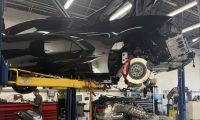Yesterday, there was an interesting discussion, going on at Tesla Model S Owners group on Facebook, in which Model S owners were discussing the biggest causes of battery, and therefore, the range loss. So what is the biggest cause of battery loss anyway?
Ivan Jue comments.
"The biggest cause of capacity loss is time, recharging cycles, and heat. A well-designed thermal management system and chemistry make a big difference to prevent capacity loss in an EV battery. So far, most Model S batteries have held up. There are a few cases where there is some capacity loss, but it looks minimal compared to the early Nissan Leafs (which have no thermal management system).
"The Leaf batteries were especially vulnerable, given the volume of cells in the pack and no active cooling capability. Regen, fast charging, and high ambient temperatures all shorten the battery lives of many Leafs in warm/hot climates."
Some Tesla Model S owners say one of the ways to minimize battery degradation and range loss is for most EVs not to use quick charging unless necessary. However, Tesla actually says range loss from using its Supercharger network is negligible because Tesla haas a good thermal management.
Also See How To Optimally Charge Tesla Model S at Home and at Work: Efficient Charging While Away.













Comments
The Leaf has no TMS?? I am
Permalink
The Leaf has no TMS?? I am also curious about how they manage the charge range of the battery. Chevy's Volt, which I personally drive, has a very conservative discharged/charge range, something like 20-80. The volt also has an extensive thermal battery management system and active cell cooling. I haven't heard anything about capacity losses with the Volt.
The LEAF has no active
Permalink
In reply to The Leaf has no TMS?? I am by Jeffrey Saxton (not verified)
The LEAF has no active thermal management. But it does have a Battery Management System to regulate the level of charging.
""The biggest cause of
Permalink
""The biggest cause of capacity loss is time, recharging cycles, and hear..." I hear you, but I think you mean "heat."
Thank you very much. Yes
Permalink
In reply to ""The biggest cause of by VFanRJ (not verified)
Thank you very much. Yes indeed. I already edited it.